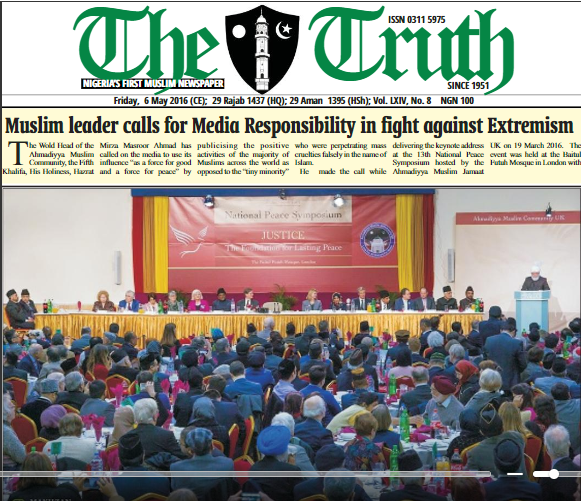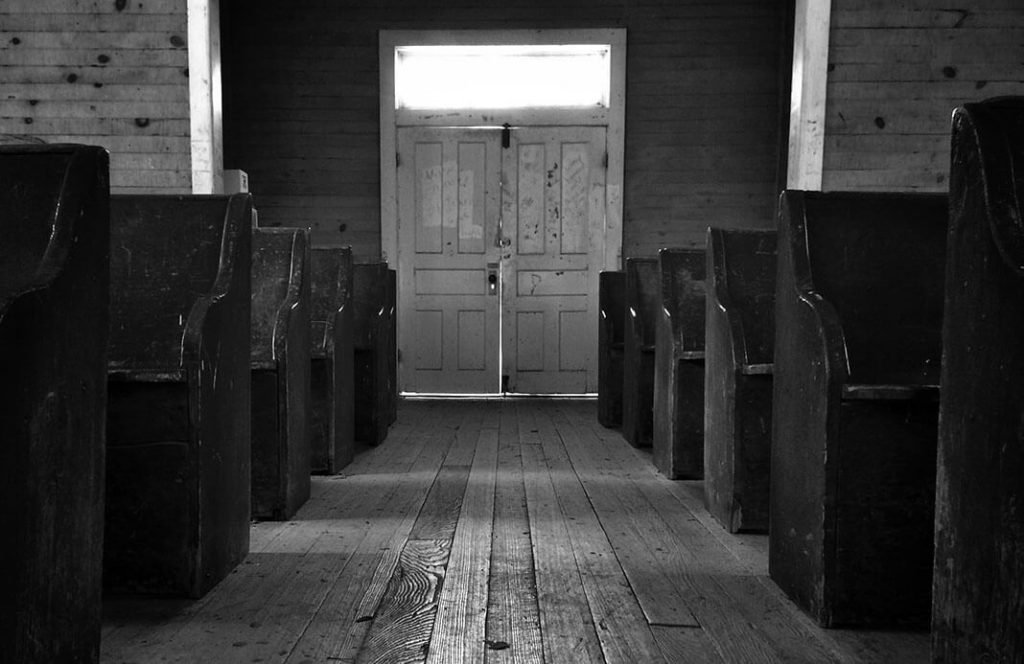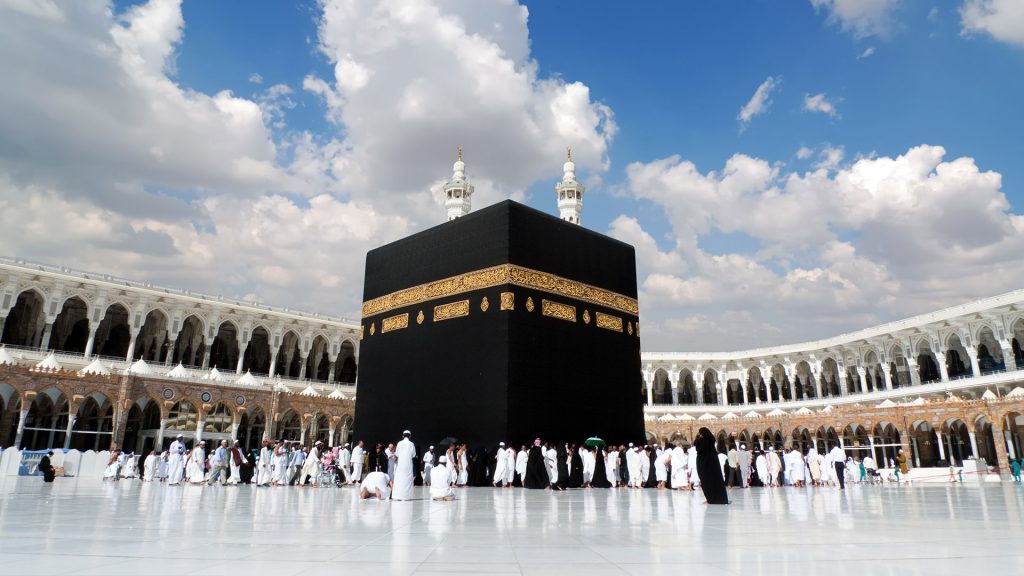WHY I ATTENDED AHMADIYYA CONVENTION IN THE U.K. – ETSU NUPE

The Etsu Nupe and the Chairman Niger State Council of Traditional Rulers, His Royal Highness, Alhaji (Dr.) Yahaya Abubakar, CFR has revealed the major reason for honouring the invitation to attend the International Convention of the Ahmadiyya Muslim Community held in the United Kingdom last year. Speaking at his Royal Palace in Bida, Niger State during the visit of the National leadership of the Ahmadiyya Muslim Jama’at Nigeria led by the Amir (National President), Alhaji (Barr.) Alatoye Folorunso Azeez, the traditional ruler disclosed that the inner impetus to have first-hand information thereby correcting the wrong impression about the Muslim Community made him attend the Conference. It would be recalled that the Etsu Nupe with other four members of his family attended the 2019 Annual Convention in the U.K. where they were given a befitting reception, and also had the rare privilege of meeting the Supreme Head of Ahmadiyya Muslim Community, Hadhrat Mirza Masroor Ahmad(May Allah be his Helper). Dr. Abubakar expressed his delight over his experience in the U.K. as he was able to ascertain the truth about the Ahmadiyya Muslim Community and its belief system which were in conformity with the tenets and true teachings of Islam. He affirmed that those attacking the Muslim organization are ignorant of its belief system and activities. Consequent to his findings, the traditional ruler informed that he summoned all leaders of Muslim sects in his domain and educated them properly. His words: “The motive behind attending the international convention of the Ahmadiyya Muslim Community in the U.K. was to actually seal the trust I had in the Jama’at and to have some clues about her belief system. I got to know that the organization believe in one God and that the Holy Prophet(Sallallahu alaehim wasalam ( was the seal of all prophets. The Community also promotes peaceful co-existence which Islam preaches, so what else? “I was really impressed and convinced after that visit. Those giving wrong allegations and are attacking the Ahmadiyya Community do that out of ignorance and sensitization. I had to gather all the leaders of Muslim organizations in my Kingdom to the palace and educate them properly after my arrival from the United Kingdom. Ever since then, they (Muslim leaders) have changed positively and are now relating to themselves peacefully.” General advice for Muslim leaders: The Etsu Nupe admonished religious leaders generally to eschew all forms of hate speech and disseminate the true teachings of Islam, notably the Peace Message which the Ahmadiyya Jama’at preaches across the globe. “Before now, some of these scholars spent much time preaching against other sects than the time spent on disseminating true teachings of Islam. This trend has changed anyway after the orientation. Let us preach on five daily prayers, Hajj, and current affairs in the society. Avoid hate speech and re-awaken followers on Islamic affairs. Let us always appreciate what God has given us and refrain from anger, jealousy, envy and embrace peaceful co-existence. This will no doubt improve the spirit of brotherhood among us,” he opined. Highlights of Amir’s Speech: Barrister Alatoye while delivering his speech expressed his profound gratitude to the Etsu Nupe for honoring the 2019 U.K. Jalsa Salana (Annual Convention) which has further bolstered the Jama’at’s relationship with members of Nupe Kingdom. He further solicited the Etsu’s full support and cooperation towards disseminating the peaceful message of the Jama’at across the country, taking into consideration current happenings in international politics. “We thank His Royal Highness for attending our international Jalsa Salana 2019 in the U.K. It’s a huge blessing for the Jama’at in all sectors. Let me use the opportunity to emphasize that the Ahmadiyya Community is very much concerned about the spreading of a peaceful message. That is why His Holiness has been moving across the world to deliver peace messages to world leaders. Aside from this, the Jama’at is also concerned about the welfare of the masses, hence the establishment of Humanity First International which focuses on the provision of food, shelter, health services, education, disaster recovery, among others for the less-privileged. We humbly request for His Royal Highness’ full support for the actualization of these programmes, starting with the spreading of peace messages across Nigeria,” Barrister Alatoye requested. His Holiness(May Allah be his Helper) Visit to Nigeria: The Amir also used the occasion to solicit Etsu Nupe’s full support for the coming of His Holiness(May Allah be his Helper) to Nigeria, especially playing an active role on His Holiness(May Allah be his Helper) meeting with the Nigeria President, National Assembly, and top government officials. Barrister Alatoye later prayed for the protection of lives and properties and abundance of blessings in the Nupe Kingdom. He then presented Jama’at literature and other gift items to the Monarch. Some of the entourage of Amir include the Missionary Incharge, Maulana Afzaal Ahmad Rauf; the General Secretary, Alhaji Abbas Iromini and the National Secretary External Affairs, Alhaji Hassan Sunmonu. Nurudeen Akinreti
Ahmadiyya Nigeria tasks NASS on development-oriented bills

The National Amir (President) of the Ahmadiyya Muslim Jama’at Nigeria, Alhaji (Barr) Abdul Azeez Folorunso Alatoye, has urged the National Assembly (NASS) to focus on bills and issues that improves the well-being of the people of the country. Azeez made this call while reacting to issues on the state of the nation during a press briefing to announce the forthcoming 67th Jalsa Salana (Islamic conference) of the Ahmadiyya Muslim Community. Alatoye enjoined the legislators to focus more on bills about developments in all facets of Nigerian life rather than being distracted with the Social Media and Hate Speech Bills. “It is of great importance to focus on issues that affects the people directly rather than legislating on issues that has already be catered for in the constitution of the country,” he said.He noted that there is enough provision in the constitution that cater for what the National Assembly is giving attention as of now. “As a lawyer, I believe there are enough extant laws in the Nigerian constitution that adequately take care of these two bills. At present we have libel law and defamation, cybercrime law and other criminal laws that can effectively accommodate any misdemeanor on the use of social media platforms and extreme comments capable of inflaming passions and causing disunity in the country.” He further stated that the democratic system of government that the country runs is expected to have the interest and welfare of the people at heart. Thus, much attention should be given to the welfare the people and policies that will aid the development of the people. He urged the National Assembly not to get distracted with things the constitution has already taken care of.“Since democracy is about the people, I urge the National Assembly to focus more on bills about developments in all facets of Nigerian life rather than being distracted with the Social Media and Hate Speech Bills.” Meanwhile, Alatoye appreciated the effort of the Federal Government on the infrastructural development of the country and urged them to do more for the good of the citizenry.He said: “The Ahmadiyya Muslim Community in Nigeria commends the commitment of the Nigerian Government to the railway transportation system. The free railway transportation between Lagos and Abeokuta is laudable. We urge the government to exert the same positive attitude to general infrastructural developments across the country.”’ In line with the core values of the Ahmadiyya Muslim Community “Love for all Hatred for None”, the 2019 edition of Jalsa Salana slated for 20th December to 22nd December will focus on the Holy Quran Chapter 16 verse 126 “Call unto the way of thy Lord with wisdom and goodly exhortation, and argue with them in a way that is best. Surely, thy Lord knows best who has strayed from his way, and He knows those who are rightly guided”. Highlights of the two-day events are praises of Allah and the Holy Prophet Muhammad (saw), message from the Worldwide Head of the Ahmadiyya Community, Goodwill messages from the Nigerian President and State Officials, Religious Leaders, Lectures, Special Prayers, and Academic Awards. Prominent invited guests expected at the event are: President Muhammadu Buhari, Vice President, Yemi Osibajo, Speaker, Nigeria House of Representatives, Femi Gbajabiamila, Governor of Ogun State, Dapo Abiodun, His Deputy, Alhaja Naimot Salako, Governor of State of Osun, Alhaji Isiaq Adegboyega Oyetola, Deputy Governor, Lagos State, Engineer Obafemi Qadri Hamzat, among others
NEW AMIR SOLICITS TEAMWORK, SINCERE DEDICATION

The new Amir (National Head) of Ahmadiyya Muslim Jamaat Nigeria Alhaji AbdulAzeez Folorunso Alatoye has called for unalloyed teamwork, rededication and overwhelming support of the National Executive officers and members of the Muslim organization in an effort to achieve a successful and hitch free administration. Alhaji Alatoye who resumes office on Monday 1st July 2019 made the call at the handing over ceremony held at the National Headquarters of the organization in Ojokoro, Lagos. It would be recalled that the Supreme Head of Ahmadiyya Community worldwide appointed Barrister Alatoye after the last shoora to succeed Dr. Mashhud Adenrele Fashola who had been at the helms of affairs for 15years. General Secretary Ahmadiyya Nigeria, Alhaji Abbas Iromini; Amir Ahmadiyya Muslim Jama ‘at Nigeria, Dr. Mashhud Adenrele and Missionary-in-Charge, Ahmadiyya Muslim Jama’at Nigeria, Murabbi Afzaal Ahmad Rauf, during the Amila meeting, at Ahmadiyya Headquarters Ojokoro, Lagos on Saturday 2019. In his speech, the new Amir who is a lawyer and tax consultant by profession opined that his administration will consolidate on the achievements and legacies of the immediate past regime and improved on them. This, he said, can only be achieved through total commitment and cooperation of all members. He thanked the former Amir for giving him the opportunity to have served in the capacity of Naib Amir (Deputy Head) for years and believed the system and administration of the organization is a continuum. The Amir, therefore, urged the incoming national executive members to be ready for the enormous task ahead. According to him, “ I have to commend Dr. Fashola for successfully steering the ship of the Ahmadiyya community in Nigeria for 15years. I have known him to be a strong individual and a spiritual person who is also energetic. The Jamaat is always proud of him in all respect. No doubt, the position of the Amir is an enormous task. The head can only succeed with the collective support of everyone. The system of the organization is a continuity,” he concluded. L-R: General Secretary Ahmadiyya Nigeria, Alhaji Abbas Iromini; Outgoing Amir Ahmadiyya Muslim Jama ‘at Nigeria, Dr. Mashhud Adenrele Fashola; Incoming Amir, Alhaji (Barr.) Abdul Azeez Alatoye and Missionary-in-Charge, Ahmadiyya Muslim Jama’at Nigeria, Murabbi Afzaal Ahmad Rauf, during the handing over ceremony at Ahmadiyya Headquarters Ojokoro, Lagos on Saturday 2019. Barrister Alatoye assured that the new regime will strive to improve on whatever is on the ground in the interest of the Jamaat and not for personal gains. Hence, he charged the executive officers and everyone to work positively going forward. He noted that “ mindset is how do we improve on what we are doing now. If you pick any concept, there would be many approaches to that concept. We need to reposition ourselves. I will also request that we reduce arguments on issues and most importantly, refer ambiguous issues to the spiritual head of the Ahmadiyya community and His Holiness for guidance and clarification. We must implement all the instructions of Huzur Aqdas (May Allah be his Helper), the Amir counseled. In his speech, Dr. Fashola said the Muslim organization was in safe hands with the new Amir and promised to give his full support for a successful regime. ” Alhaji Alatoye is a blessed person by all standards. He is a man of discipline, a man of God and a prayer warrior. He has all the qualities and attributes of a good leader. I will give him all the support needed because he also supported me a lot,” he said. L-R: General Secretary Ahmadiyya Nigeria, Alhaji Abbas Iromini; Outgoing Amir Ahmadiyya Muslim Jama ‘at Nigeria, Dr. Mashhud Adenrele Fashola; Incoming Amir, Alhaji (Barr.) Abdul Azeez Alatoye and Missionary-in-Charge, Ahmadiyya Muslim Jama’at Nigeria, Murabbi Afzaal Ahmad Rauf, during the handing over ceremony at Ahmadiyya Headquarters Ojokoro, Lagos on Saturday 2019 Other New officers Similarly, new officers have emerged in eight positions of the Jama’at for the next three years. The new officers are Barrister Muhammad Bashir Badr who succeeded Dr. Saheed Timehin as the National Secretary Tabligh (Preaching). Alhaji Mudathir Dada replaced Dr. Qasim Akinreti as the National Secretary Isha’at (Publications). Alhaji Abdul Ghaniy Idrees also handed over to Alhaji Mudathir Adefarati as the Finance Secretary L-R: Former Financial Secretary, Alhaji Abdul Ghaniyy Idris handing over to Bro. Mudathir Adefarati, during the handing over ceremony at Ahmadiyya Headquarters Ojokoro, Lagos on Saturday 2019. while Alhaji Hassan Sunmonu took over from Alhaji Hussein Sunmonu as the National Secretary External Affairs. Engineer M.A Alli equally succeeded Alhaji Muili Olagunju as the National Secretary General Affairs L-R: Former Welfare Secretary, Alhaji Olagunju handing over to Engr. Musliu Aliu, during the handing over ceremony at Ahmadiyya Headquarters Ojokoro, Lagos on Saturday 2019. and Alhaji Z. A Junaid handed over to Engineer Shakirudeen Abdussalam as the National Secretary Wasayya (Wills). L-R: Former Wsiyyat Secretary, Mr. Z. Junaidu handing over to Engr. Abdul Salaam, during the handing over ceremony at Ahmadiyya Headquarters Ojokoro, Lagos on Saturday 2019. Mr. Hussein King replaced Alhaji Muheeb Idrees as the Internal Auditor while Engineer Abdul Waheed Adeoye handed over to Engineer Imran Adeyemi as the National Audio-Visual Secretary. L-R: Former Audio-Visual Secretary, Alhaji (Engr.) Adeoye Abdul Waheed handing over to Bro. Adeyemi Imran, during the handing over ceremony at Ahmadiyya Headquarters Ojokoro, Lagos on Saturday 2019. Among the dignitaries present at the ceremony include the Missionary In-charge Maulvi Afzal Ahmad Rauf; L-R: General Secretary Ahmadiyya Nigeria, Alhaji Abbas Iromini; Outgoing Amir Ahmadiyya Muslim Jama ‘at Nigeria, Dr. Mashhud Adenrele Fashola; Incoming Amir, Alhaji (Barr.) Abdul Azeez Alatoye and Missionary-in-Charge, Ahmadiyya Muslim Jama’at Nigeria, Murabbi Afzaal Ahmad Rauf, during the handing over ceremony at Ahmadiyya Headquarters Ojokoro, Lagos on Saturday 2019. the Naib Amir, Northern zone Alhaji. Yaqeen Habeeb; Naib Amir Special Duties Alhaji Ahmed Alhassan and former Amir AMJN Alhaji Hussein Sunmonu. L-R; Former Amir, Engr. Hussein Sunmonu Naib Amir Northern Region, Dr. Yaqeen Habeeb; Naib Amir South West, Alhaji (Barr.) Abdul Azeez Alatoye and Naib Amir Special Duties, Engr. Ahmed Al-Hassan, during the Amila meeting, at
The Truth Newspaper

Established in 1951, The Truth Newspaper is the first Muslim newspaper in Nigeria. It continues to report Islamic news from across the globe. Publication of Ahmadiyya Muslim Community in Nigeria. https://thetruth.ng/
100 Years Ago… – News from Jamaats around the world

Al Fazl, 21 June and 24 June 1919 Qazi Abdullah Sahib’s letter to Hazrat Khalifatul Masih on the impact of Haqiqat-ul-Roya My beloved master, Hazrat Khalifatul Masih (may Allah be his helper) Assalamo Alaikum wa Rahmatullahi wa Barakatohu Although Haqiqat-ul-Roya, a collection of Huzoor’s lectures delivered at Jalsa Salana in 1917 was received late, but reading them had a delightful impact on the heart. Every word was refreshing. It served as an extremely sublime spiritual nourishment for the soul. One’s heart is filled with divine light, and extraordinary energy and contentment are granted for further sacrifice. At this very moment, I find not a single challenging matter which could prove to be a hurdle for me in embarking the most cherished way. Huzoor’s pearls of wisdom had an electrifying effect on me. Efficacy of Hazrat Khalifatul Masih’s prayer An extraordinary sign of the fulfillment of Huzoor’s prayer was witnessed recently. Apparently, there were no signs of brother (…), a new Ahmadi convert, being released [from prison]. According to the prison governor, several Indians were more likely to be released before him and above all, it was impossible for the governor to recommend his release. Repeated requests were made to the home secretary which were rejected every single time. In spite of the adverse conditions, through the blessings of Allah the Almighty which were absorbed by the prayers of Huzoor, such circumstances were created miraculously that the new Muslim convert was released while the others who were more likely to be released remain behind bars. Tract for tabligh A short tract has been sent for printing. 10,000 copies have been ordered for the time being. During this time of the year, I intend to carry out tabligh moving about on foot. I observed istikhara [prayer seeking good from Allah] at night and all of a sudden, before getting up, I was whispering the following words: وَاسْتَفْتَحُوا وَخَابَ كُلّ جَبَّارٍ عَنِيْدٍ “And they prayed for victory, and as a result thereof, every haughty enemy of truth came to naught.” This humble one prays for Huzoor and I request Huzoor from the depth of my heart to pray for me. Wassalam; Huzoor’s humble servant, Qazi Abdullah Qazi Abdullah Sahib’s health A telegram received from Mufti Muhammad Sadiq Sahib on 16 June indicates that Qazi Abdullah Sahib’s health is relatively better than before, all praise belongs to Allah. Members of the Jamaat are requested to pray that Allah the Almighty grants him full recovery from illness. (Editor Al Fazl) Tabligh in the UK The truth of Islam lies in its pure teachings which is being acknowledged by the people of Europe after thorough research. Listening to this week’s lecture of Qazi Abdullah Sahib in the Lecture Hall, Star Street, London, a revered gentleman and his lady who already had a discourse with him in Hyde Park, openly admitted in front of the audience that the lecture was well reasoned and true and that they totally agree with it. Another respected lady, by the name of Miss Bobby South, embraced Islam through Hazrat Mufti Sahib. She was given the Islamic name Maryam and her request of Bai‘at has been sent to Hazrat Khalifatul Masih. Servant of religion; MS Abbasi 4 Star Street, London, W2. (21 May 1919) Recent letter from Malabar Through the blessings of Hazrat Khalifatul Masih’s prayers, a discussion was held with three paighamis [those Ahmadis who had not accepted Khilafat]. By the grace of Allah, truth has become clear upon them and they have sent a request for Bai‘at to be presented before our Imam, Khalifatul Masih II. Their names are B Muhammad Kunji Sahib, G Muhammad Sahib and K Kunji Ahmad Sahib. Mahmud Ahmad Al Fazl, 24 June 1919 By the grace of Allah the Almighty, tabligh is being carried out exceptionally well. According to the weekly report, an English gentleman named Mr Scott, inhabitant of Islington, embraced Islam through Mufti Muhammad Sadiq Sahib. He was given the Islamic name Ibrahim. All praise belongs to Allah. At the Lecture Hall on Sunday evening, Hazrat Mufti Sahib delivered an address on The Blessings and Qualities of Islam in a very interesting manner. It had a positive impact on the new Muslim converts and the remaining audience which was fairly numbered. This humble one went to Southend-on-Sea on a tabligh visit where a number of people were spoken to about the verities of Islam Ahmadiyyat, aside from a public lecture. Moreover, literature was distributed. Wassalam; Humbly yours, Qazi Abdullah 4 Star Street, London, W2. (28 May 1919) A letter from Malabar A recent letter from Sheikh Mahmud Ahmad Sahib indicates that the health of Maulvi Ghulam Rasul Sahib is on the road of recovery and the wound is healing. However, in spite of extreme weakness and loss of strength, which at times led to unconsciousness, Maulvi Sahib continued to carry out tabligh and sent letters to the chiefs of that region composed in Arabic. Ahmadiyyat in Shimoga (Mysuru) Bombay’s missionary, Hakim Khalil Ahmad Sahib went to Shimoga for some days, [then] part of Mysuru’s region. There was only one Ahmadi, Mir Kalimullah Sahib (thekedar) at that time. By now, through the blessings of Allah the Almighty, a Jamaat has been established there. It has become known from Hakim Sahib’s letter that as per the needs, a mosque has been built in a matter of only a few days. Hakim Sahib will send a detailed report from Bombay. WHY I ATTENDED AHMADIYYA CONVENTION IN THE U.K. – ETSU NUPE The Etsu Nupe and the Chairman Niger State Council of Traditional Rulers, His Royal Highness, Alhaji (Dr.) Yahaya Abubakar, CFR has revealed the major reason for honouring the invitation to attend the International Convention of the Ahmadiyya Muslim Community held in the United Kingdom last year. Speaking at his Royal Palace in Bida, Niger State during the visit of the National leadership of the Ahmadiyya Muslim Jama’at Nigeria led by the Amir (National President), Alhaji (Barr.) Alatoye Folorunso Azeez, the traditional ruler disclosed that the inner impetus to have first-hand information thereby correcting the wrong
100 Years Ago… – News highlighting the progress of Ahmadiyyat

Al Fazl, 3-7 June 1919 Hazrat Master Abdur Rahim Nayyarra The peaceful teachings of the Ahmadiyya Jamaat and the practical display of sincerity and loyalty by Ahmadis towards Britain is generating feelings of love in the hearts of several officials. This phenomenon is not confined to India but in fact, it can be observed outside of India as well. Hence, a friend states [from the UK] that a person who had been living with an Ahmadi from a long time went to a British officer in order to find work. When the officer began to interview the applicant and asked about his place of residence, he replied that he lived with an Ahmadi. Thereupon the following discussion took place: Officer: Are you an Ahmadi as well? Applicant: [Afraid that the officer might be offended by the name of an Ahmadi] No sir! Officer: It is strange that you have been living with an Ahmadi for such a long time, but you have not accepted the truth. Go and become an Ahmadi first and come back (on a certain date). We are grateful to Allah the Almighty that several officials have reverance for the honesty, sincerity and loyal sentiments of Ahmadis. A pious judge News has come in from a foreign country that opponents have filed a false case against Ahmadis. Before appearing in court, the Ahmadi lawyer handed over several books of the Ahmadiyya Jamaat to the judge in order to inform him about its beliefs. The honorable judge read these books and said: “Before reading these books, I used to believe that the Holy Prophet[sa] was (God forbid) a dishonest and deceitful person. However, after going through these books, my point of view changed, so much so that my wife and I began to constantly repent and in fact, we became quite perturbed for our wellbeing.” May Allah the Almighty enable him to become an Ahmadi Muslim. An officer’s life saved The young man who saved the life of Lieutenant […] at Hafizabad railway station was Bashir Hayat Ahmadi, son of sub-inspector, Muhammad Hayat Sahib Ahmadi. We are proud at the loyal act of this Ahmadi gentleman. The promulgation of Ahmadiyyat in Rohilkhand Hafiz Syed Mukhtar Ahmad Sahib Mukhtar Shahjahanpuri writes: “During the past three years, Ahmadiyyat has progressed and continues to advance parallel to the increase in intensity and vehement opposition in several districts. Since the initiation of opponents’ gatherings, 40 individuals have accepted Ahmadiyyat in Pilibhit Bareilly and Shahjahanpur. The increase in numbers of the Ahmadiyya Jamaat during the past three years has never been witnessed before, even in decades long periods. “It becomes evident from the current climate that as the rising opposition causes difficulty and brings about the loss of wealth and life for Ahmadis, by the grace of Allah the Almighty, it also serves as a remarkable means for the progress, promulgation and introduction of Ahmadiyyat. “The present condition is such that in the last week of April, 15 individuals of Bareilly accepted Ahmadiyyat. Today, two young men of Shahjahanpur sent their requests of Bai‘at. Their acceptance of Ahmadiyyat will be a source of blessings for the Ahmadis of Shahjahanpur, Insha-Allah. Among these gentlemen is Syed Qutbuddin Sahib, son of Maulvi Syed Muinuddin Sahib who translated the book Napoleon Azam. It is quite fascinating that in the same week, when the wording of Maulvi Muinuddin Sahib’s translated book was presented in the article discussing an earthquake as a proof for the meaning of war to also be taken from the word ‘earthquake’, Syed Qutbuddin Sahib entered the pale of Ahmadiyyat.” Syed Qutbuddin Sahib’s request of Bai‘at “Syedi [my master] and Maulai [my leader]; Assalamo Alaikum wa Rahmatullahi wa Barakatuhu!During the past three months, I became well informed by reading the fine works of Jariyullah fi Hulalil Anbiya [the champion of Allah in the mantle of all the prophets], the Promised Messiah and Imam Mahdias and several books of beloved Huzoor [Hazrat Khalifatul Masih IIra]. I carried out discussions about Ahmadiyyat and listened to certain discourses. I attended non-Ahmadi gatherings that were conducted here this year and read several books of theirs. Moreover, I compared some books to each other. Consequently, Allah the Almighty granted me strength to reach this conclusion that Hazrat Jariyullahas [the Promised Messiahas] was truthful and honest in all his claims. Thus, I respectfully request beloved Huzoor to bless me with the honour of Bai‘at and pray for me to remain resolute and steadfast. Your servant, Syed Qutbuddin.” Syed Shujaat Hussain Sahib’s request of Bai‘at “Syedi [my master] and Maulai [my leader]; Assalamo Alaikum wa Rahmatullahi wa Barakatuhu! I had the opportunity to examine several books of the Promised Messiahas here. Once I finished reading Kitab-ul-Bariyyah, by the grace of Allah the Almighty, the truth became completely manifest upon me and I was fully satisfied that the Promised Messiahas was truthful in all his claims. Now, I wish that beloved Huzoor [Hazrat Khalifatul Masih IIra] bless me with the honour of Bai‘at and pray that I remain resolute and steadfast. Wassalam; Your humble servant, Shujaat Hussain of Shahjahanpur, Overseer at the Court of […].”
WW3 is on the Horizon – Find out how together, we can #STOPWW3 – Join Our Campaign

Find out how together, we can #STOPWW3 Join us here – #STOPWW3
The Messiah Has Come

In 1835, Mirza Ghulam Ahmadas was born in the unknown village of Qadian, India. In 1889, he founded the Ahmadiyya Muslim Community. By the end of his life he had hundreds of thousands of followers. Today, his peaceful community numbers in the many millions, and grows at a remarkable rate each year. Its adherents hail from every faith, nation, and walk of life. Among his followers are Nobel Prize winners, United Nations Director-Generals, and celebrated authors, artists, and leaders of nations. They all claimed that by following Ahmad they achieved something no longer seen in the contemporary world — a genuine, two-way connection with our Creator; spiritual enlightenment in our age of darkness. Ahmad made a remarkable claim. He said that he was the long-awaited Messiah and Reformer foretold by Christianity, Islam and countless other religions. He said that as Islam was the universal religion, the Reformer to come in this age was to be a single man, born and raised in the all-embracing Muslim faith. But what of the first Messiah, Jesus? With Biblical, Quranic, and historical argumentation he proved that Jesus of Nazareth survived the crucifixion, fled East and died a natural death in India. Ahmad claimed that the old Jesus would never come back, and second coming of Jesus that Muslims and Christians alike await was a spiritual rebirth, rather than a physical descent from the skies. He claimed to be a Prophet for our time, a deputy to the Prophet Muhammad, peace be upon him, who was and always will be the greatest of all Prophets. Ahmad did not rest with claims alone, but proved them with ceaseless intellectual output and the testimony of heavenly signs. Thus was the long-awaited double eclipse in the month of Ramadan fulfilled in his lifetime. Thus did he call those who branded him a liar to prayer duels and emerge in humble victory. Thus did his prophecies foretell the Great War and countless other world events. But his truest proof lay in the spiritual revolution that he created among his followers. The connection that they forged with God by following Ahmad brought with it fresh inspiration and revelation. This contact with the Divine sustained the spiritual lives of his followers 125 years ago, and continues to do so today. Over half a million join each year — their stories of Divine Experience are numberless. Ahmad had no political ambitions. He shunned the world and lived a life of hardship and restraint. His community does not seek to conquer lands, but to conquer hearts. Its aim is to reconnect man with God, and to reconnect the hearts of humanity with each other. Its method is simple: to follow the true teachings of Islam, as revealed in the Holy Qur’an to the Prophet Muhammad, peace be upon him. It does so under divine guidance, in the form of elected spiritual successorship known as Caliphate. Today we live under the fifth Caliph, Mirza Masroor Ahmad, an internationally renowned ambassador of peace, and a beacon of spiritual guidance. He travels the world purveying the message of Islam Ahmadiyya, the True Islam. This Islam is far removed from the fanaticism of extremists, and is the path to spiritual, social, and international peace that our world so sorely needs.
Khilafat

Introduction A Khalifa literally means a ‘successor’. Khalīfah is an Arabic word used in the Qur’an to denote a person who succeeds or represents a forebear. The institution as a whole is called Khilāfah, which is referred to on the Indian Sub-continent as Khilafat. The Holy Qur’an specifically promises the Muslim Community that ‘Khilafat’, or ‘successorship’ will remain among them after the demise of the Prophet Muhammadsa, Allah has promised to those among you who believe and act righteously, that He will surely make them Successors (Khulafā) in the earth, as He made Successors from among those who were before them; and that He will surely establish for them their religion, which He has chosen for them; and that He will surely grant them security and peace in place of their fear.(Holy Qur’an, 24:56) This verse clearly and explicitly foretells the appearance of Khulafā, (the Arabic plural of ‘Khalifa’), among the Muslims as there were among previous peoples. These Khulafa will come to establish the faith, and to give people ease and security at a time of fear. The Promised Messiah, Hazrat Mirza Ghulam Ahmadas explained the need for Khulafa as follows: ‘A successor is called a Khalifah. The successor of a prophet in the real sense can only be the one who has the excellences of a prophet on a shadowlike basis…in fact a Khalifah is the shadow of a prophet. As no person can live forever, therefore Allah the Exalted willed to establish the beings of prophets, who are the most eminent and the best among all the beings of the world, on a shadow-like basis till the Day of Judgement. It is with this objective that Allah the Exalted chose Khilafat so that the world may never and at no time be deprived of the blessings of prophethood.’ The Prophet Muhammadsa elaborated on the future appearance of Khilafat among his followers in a well-known narration: HIS HOLINESS MIRZA MASROOR AHMADATBA KHALIFA OF THE AHMADIYYA MUSLIM COMMUNITY “Prophethood shall remain among you as long as God wills. Then khilafat on the pattern of prophethood will commence and remain as long as He wills. A corrupt monarchy shall then follow and it shall remain as long as God wills. There shall then be a tyrannical despotism which shall remain as long as God wills. Then once again khilafat will emerge on the precept of prophethood.” (Masnad-¬Ahmad, Mishkat, Chapter Al-Anzar Wal Tahzir). Thus the Prophet Muhammadsa foretold that after his demise, true spiritual Khilafat will emerge. Then would follow various phases of Islamic rule, each worse than the last, before ‘Khilafat on the precepts of Prophethood’ would reappear once more. History has borne witness that every word of the Holy Prophetsa has been fulfilled. After his own passing, there emerged spiritual leadership in the form of the four Rightly-Guided Khulafa. Then there followed age after age of successive Muslim leadership, the integrity of which dissipated every century. Then, in the 19th Century, came the advent of the Promised Messiahas, a follower-prophet after the Prophet Muhammadsa. After Hazrat Mirza Ghulam Ahmad’s demise, there once again appeared Khilafat ‘on the precept of Prophethood,’ providing spiritual guidance in an age of worldly decadence. The current Khalifa of the Ahmadiyya Muslim Community is Hazrat Mirza Masroor Ahmadatba, a spiritual light in this age of darkness, renowned throughout the world as a tireless campaigner for international peace and justice. *** If you want to learn more about Khilafat after reading through these pages, you can discover more articles, books, and multimedia on the http://www.alislam.org website. Types of Khilafat The 2nd Khalifa of the Ahmadiyya Muslim Community, Hazrat Mirza Bashirrudin Mahmud Ahmadra delineated the different kinds of Khilafat in his erudite commentary on the following verse: Allah had promised to those among you who believe and do good works that He will surely make them Successors in the earth, as He made Successors from among those who were before them; and that He will surely establish for them their religion which He has chosen for them; and that He will surely give them in exchange security and peace after their fear: They will worship Me, and they will not associate anything with Me. Then who so is ungrateful after that, they will be the rebellious. (Holy Qur’an, 24:56) He explained: ‘The present verse embodies a promise that Muslims will be vouchsafed both spiritual and temporal leadership. The promise is made to the whole Muslim nation but the institution of Khilafat will take a palpable form in the person of certain individuals who will be the Prophet’s Successors and the representatives of the whole nation. They will be, as it were, Khilafat personified. The verse further says that the fulfilment of this promise will depend on the Muslims’ observing the Prayer and giving the Zakat and on their obeying the Messenger of God in all religious and temporal matters concerning the nation. When they will have fulfilled these conditions, the boon of Khilafat will be bestowed upon them and they will be made the leaders of nations; their state of fear will give place to a condition of safety and security, Islam will reign supreme in the world, and above all the Oneness and Unity of God – the real purpose and object of Islam – will become firmly established. The promise of the establishment of Khilafat is clear and unmistakable. As the Holy Prophet is now humanity’s sole guide for all time, his Khilafat must continue to exist in one form or another in the world till the end of time, all other Khilafahs having ceased to exist. This is among many others the Holy Prophet’s distinct superiority over all other Prophets and Messengers of God. Our age has witnessed his greatest spiritual Khalifa in the person of Ahmad, the Promised Messiah. The Qur’an has mentioned three kinds of Khulafa: Khulafa, who are Prophets such as Adam and David. About Adam, God says in the Qur’an: “I am about to place a vicegerent in the earth” (2:31); and about David He says: “O David, We have made thee a vicegerent in the earth”
Islam – Introduction

What does Islam really teach? What are its fundamental beliefs, and what are the actions it enjoins? What is the Qur’an, and what wisdom does it contain? These pages seek to answer these questions, and give the reader a perfect starting point to learn about this great faith. We start with the Articles of Faith, which are the six core beliefs of Islam. As it is a key principle in Islam that belief must be put into action, we then move onto the Pillars of Faith, which are the five key religious acts to be performed by Muslims. Thereafter we discuss the Qur’an, and offer an overview of Islamic History. Please note that the letters (sa)/pbuh or (as) appearing after the name of the Prophet Muhammadsa and other Prophets respectively, indicates an Arabic honorific translating to ‘peace be upon him.’ (ra) indicates ‘May Allah be pleased with him/her.’ Further Learning Once you’ve exhausted the pages on this website, you may want to know where else you can learn about Islam! For that reason, we’ve compiled some further sources of education below. Books An Elementary Study of Islam By Hazrat Mirza Tahir Ahmad This book, written by the blessed 4th Khalifa of the Ahmadiyya Muslim Community, provides an insightful overview of the core teachings of Islam. Much of this section is excerpted from this wonderful introduction. Read it now. Holy Qur’an with Short Commentary This publication of the Ahmadiyya Muslim Community is a perfect introduction to the text of the Qur’an itself. With an easy-to-read English translation, and commentary summarised from the 2nd Khalifa’s, the book constitutes a short but in-depth primer to Qur’anic scholarship. Read it online or by PDF. Philosophy of the Teachings of Islam By Hazrat Mirza Ghulam Ahmad This classic of Ahmadiyya literature has introduced countless souls to the world of Islam. A deep and revolutionary analysis of the Islamic teachings by the Promised Messiah himself. Enlightenment awaits! Read it now. You can find countless more books freely available on the Alislam library. Multimedia MTA International The revolutionary broadcasting channel of the Ahmadiyya Muslim Community, MTA (Muslim Television Ahmadiyya) now has several different channels with endless content on Islam 24/7. See it on YouTube, watch live on its website, or visit channel 787 on Sky TV. Alislam.org Alislam is the international homepage of the Ahmadiyya Muslim Community. It is a repository of information on Islam and the Ahmadiyya Muslim Community, featuring thousands of books, articles, and hours of media production. Visit Alislam now. Ask Islam This is a treasure-trove of information on every subject, excerpted from audio recordings of the late 4th Khalifa of the Ahmadiyya Muslim Community, Hazrat Mirza Tahir Ahmad. Just search your query, and find an answer! Visit now. The Tahir Archive This YouTube channel collects all the video material of the 4th Khalifa of the Ahmadiyya Muslim Community, Hazrat Mirza Tahir Ahmad. Here you can find full original Q&A sessions, lectures delving into the depths of Holy Qur’an teachings, and videos with translations into many of the world’s languages. A must watch for further education on Islam. Watch it online here. Articles of Faith Belief in God’s Unity The following article was written by the 4th Khalifa of the Ahmadiyya Muslim Community, Hazrat Mirza Tahir Ahmad, in his much-lauded book, An Elementary Study of Islam. *** This seems to be a rather simple and elementary concept. It should not be difficult for anybody to understand the oneness of God, and there the matter seems to rest. But in fact there is far more to this than meets the eye. When one examines the concept of Unity in depth, the entire world of religion seems to revolve around this pivotal point. This belief influences man’s life in all its aspects. It also implies the negation of all else but God. So belief in the oneness of God is not the end-all of belief, but all other beliefs spring from this fountain-head of eternal truth. This also delivers a message of liberation from all other yokes and releases man from all obligations except such as is born out of his submission to God. This article has been further elucidated from different angles, both in the Holy Qur’an and the traditions of the Holy Prophet(sa) of Islam. For instance, the declaration ‘La houl wala quat illa Billah’ (There is no all-encompassing power except Allah) opens up new windows for a deeper and wider understanding of Unity. It negates all fears other than the fear of God. The second part of the same brings to the focus of attention another very important aspect of Unity, i.e. that the power to achieve good is solely dependent on God and that He is Master of all sources of strength and energy. Hence while the first part relates to the negative aspects of power, the second part relates to the positive. In application to human actions, intentions and motivations etc., these two forces are all-encompassing. Man’s intentions and his subsequent actions are always guided and controlled either by fear or hope and there is no exception to this rule. Those who do good deeds do so out of fear and hope, and those who indulge in vices are motivated by the same. The fears of non-believers belong to the negative ungodly category, and they shape their lives in accordance with these worldly fears. Sometimes they are afraid of earning the displeasure of monarchs and authorities, sometimes they are afraid of society in general or of despots and bullies. Again, sometimes they act evilly out of a fear of poverty and loss etc. So, in a world full of vices, a large part of human actions can be explained with reference to these fears. The belief in Unity dispels these fears altogether and brings to one’s mind the importance of the fear of God, which means that one must not be afraid of the displeasure of the ungodly, but should always endeavour to avoid displeasing God and shape one’s life according to that fear alone. In the positive sense, the same applies to all human motivations and consequent
